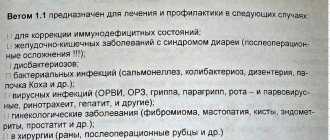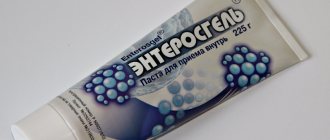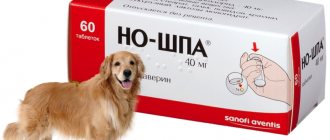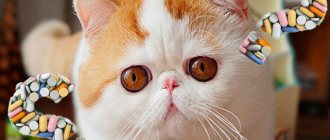Ceftriaxone is an antibacterial agent that is widely used to treat infectious processes caused by the activity of pathogenic microorganisms. The drug has gained wide popularity both in the treatment of human diseases and in veterinary practice. This is an effective, potent medicine that requires caution in use and compliance with medical recommendations. How is Ceftriaxone used for cats , and what do animal owners need to know about this drug?
Ceftriaxone for cats
General description of the drug
Ceftriaxone is a third-generation antibiotic from the cephalosporin family, which inhibits the activity and proliferation of pathogens. By suppressing the synthesis processes occurring in the walls of bacteria, it quickly destroys foreign agents, has a long-lasting effect and is effective against pathogens of a number of diseases.
Ceftriaxone is a third generation cephalosporin antibacterial agent.
The main active ingredient of the drug is ceftriaxone (sodium salt). The drug is used for intramuscular administration, available without a prescription in the form of a white, milky or yellowish powder, which is packaged in transparent bottles of 0.25, 0.5 or 1 g. It is diluted with a special liquid in combination with anesthetics - novocaine or lidocaine, after which administered intramuscularly according to the regimen prescribed by the doctor.
For reference! Ceftriaxone is available exclusively in the form of a powder for intramuscular injection, so if you cannot give injections to your animal for any reason, you need to consult a veterinarian to replace the drug with another one.
Application
Ceftriaxone causes pain, so the preferred eluents for it are analgesics - Lidocaine 1%, Novocaine 0.5%. For intramuscular or subcutaneous administration, the drug is dissolved in 3.6–4.0 ml of eluent. At this dilution, 1 ml contains 250 mg of the active ingredient. The dosage is 20–40 mg/kg of body weight and is specified by a veterinarian. In most cases, a single injection per day is indicated. For intravenous use, use mixtures of analgesic with saline, at the discretion of the doctor.
Ceftriaxone is a potent and unsafe antibiotic, so it must be used under the supervision of a veterinarian, especially when administered intravenously. The drug is used for diseases of the following animal species:
For ruminants and pigs
In severe cases, intravenous infusion is prescribed for three days in a row, followed by intramuscular administration for 5 days.
The contents of the bottle are diluted with a mixture of Lidocaine and saline solution, 2 cm each. The dosage for cows is 20 mg/kg. That is, with a weight of 5 kg, the animal needs to pierce 10 bottles per day. For a goat, an acceptable dose is 30-40 mg/kg - a bottle per day. Possible complications include stopping the scar or the occurrence of secondary fungal infections, which are prevented by prescribing antimycotics. For decorative breeds of pigs, the dosage increases to 50–75 mg, that is, the contents of the bottle are designed for an individual weighing 35–50 kg.
For poultry and rabbits
The dosage for poultry is 75–100 mg/kg. To obtain the desired effect, injections are required every 4–8 hours, over 1–2 days. The rabbit portion is 40 mg, 2 times a day, for two days in a row.
For canines and cats
Cats are sensitive to lidocaine overdose. Therefore, another analgesic is indicated for them. The course of treatment lasts 5–10 days with a single intramuscular injection. The contents of the bottle are designed for a dog weighing 25–50 kg. For cats weighing up to 2 kg, 0.5 ml of solution is injected; large individuals are injected with 1 cm 3.
After treatment, rehabilitation may be required - Ceftriaxone destroys bacteria that compete with fungi, as well as the microflora of the large intestine. Therefore, antimycotics and probiotics will be required. The veterinarian can use a cephalosporin drip mixed with saline or 5% glucose.
What cat diseases are treated with Ceftriaxone?
The antibiotic is a broad-spectrum agent and is effective against many pathogenic microorganisms - these include various cocci (staphylococcus, pneumococcus, streptococcus), as well as E. coli, Legionella, Klebsiella, etc. Ceftriaxone injections are indicated for cats with infectious, inflammatory and septic processes caused by microorganisms sensitive to the effects of the active substance. Indications for the use of antibiotics include infections of the following organs:
- digestive tract;
- bone and nerve tissue (osteomyelitis, meningitis);
- urinary and reproductive system;
- respiratory and ENT organs.
What are antibiotics and what are they?
In addition, Ceftriaxone is often prescribed to cats after bites from other animals along with anti-rabies therapy and to prevent postoperative complications during castration, sterilization and other surgical interventions.
The drug is prescribed exclusively by a veterinarian, taking into account the clinical course of the disease, age, characteristics of the animal’s body and other factors. You cannot prescribe Ceftriaxone on your own - it can cause serious harm to the cat’s health, and also cause bacteria to become resistant to the active substance, which will make it much more difficult to cure the disease.
The drug has a wide spectrum of effects and is recommended for various infectious diseases
Attention! Despite the wide spectrum of action and effectiveness of Ceftriaxone, it is useless against Bacteroides fragilis, enterococci and some varieties of Staphylococcus aureus.
Veterinarian's appointment
Veterinarians prescribe Ceftriaxone to cats after undergoing surgical operations in order to exclude the development of infectious diseases and for recovery from long-term illnesses caused by harmful microorganisms. In addition, this drug is prescribed for the treatment of diseases:
- genitourinary system (the medicine effectively prevents and treats diseases such as cystitis, for example);
- respiratory tract (bronchitis, pneumonia, etc.);
- it is used to fight infections of the gastrointestinal tract;
- with skin infections;
- otitis, meningitis, osteomyelitis, chlamydia.
Injection sites
How to use Ceftriaxone for cats
According to the instructions for use, it is necessary to prepare a solution for intramuscular administration from Ceftriaxone powder according to certain rules.
- For Ceftriaxone therapy, it is necessary to additionally purchase ampoules of sterile water for injection and novocaine. Dry granules are diluted at the rate of 1 g per 2 ml of water and 2 ml of novocaine - the resulting product contains approximately 250 mg of the active substance.
To reduce pain during injection, Ceftriaxone is diluted with novocaine
- To prepare a solution for intramuscular injection, you need to draw sterile water and novocaine into a syringe, insert the needle into the container with the powder through the rubber cap, after removing the protective sheath, and release the liquid. Shake the bottle slightly so that the dry and liquid components mix well, resulting in a clear yellowish solution (a small amount of sediment is acceptable).
- Change the needle, draw the required amount of solution into the syringe - the standard dosage is 0.5 ml of the finished product with a weight of less than 2 kg, if the cat’s weight exceeds 2 kg, you will need 1 ml, then give the pet an injection.
Ceftriaxone is quickly and almost completely absorbed by the body, after which it is carried along with the bloodstream, penetrates all tissues and has a prolonged effect, so it is administered to the animal once a day, the course of treatment is 1-2 weeks.
The drug can be mixed with sterile water for injection without the use of anesthetics, but in this case the injections will be extremely painful. Lidocaine is often used to prepare the solution, which has a more pronounced analgesic effect, but when treating cats it is better to use novocaine. Lidocaine often causes allergic reactions in cats, including anaphylactic shock and has a negative effect on the cardiovascular system.
Attention! Ceftriaxone can be injected into cats only intramuscularly - subcutaneous injections are strictly prohibited.
Video -How to dilute an antibiotic for injection
How it works
The drug is used for 7-10 days in a row with a single administration once a day.
As a standard, the medicine is stopped administered three days after the temperature returns to normal and all symptoms of the disease disappear. The course of treatment cannot be interrupted, even if there is a visible improvement in the pet’s condition, remember that this is an antibiotic!
It happens that injections have been administered for 3-5 days, but there is still no result, or even the cat’s condition has begun to worsen. There is no need to wait; with such serious problems, see a doctor immediately!
How to give a cat an injection of Ceftriaxone
The drug is injected into the back of the animal's thigh using an insulin syringe - it has a short and thin needle, due to which the cat will feel less discomfort, and the risk of damage to soft tissues and nerve endings is reduced. The injection site is determined 2-3 cm above the joint of the hind paw on the outside. It is better to carry out the procedure together with an assistant - even when using Novocaine, Ceftriaxone injections remain quite painful, and the cat will probably struggle or use its claws and teeth.
- The cat should be well secured and gently, calmly talk to it.
- Lightly stretch the animal's paw to determine the thickness of the muscle tissue and select the location where the injection will be given.
- With a confident but gentle movement, insert the needle to a depth of 1-1.5 cm, holding the syringe at an angle of 45 degrees to the surface of the body, slowly release the solution, and treat the injection site with an antiseptic.
- Massage the thigh and calm the pet again.
Due to the fact that the administration of Ceftriaxone causes serious discomfort, it is better to administer it alternately: first into one, then into the other thigh.
The medicine is administered to cats in the thigh exclusively intramuscularly.
How to give a cat an intramuscular injection at home? Why learn to give injections yourself? Advantages and disadvantages of intramuscular injections. We select syringes and needles for injections for cats. How to properly restrain your cat before injection. Injection technique. Possible complications in a cat after the injection. You will learn about this by reading the material on our portal.
Video - How to give an intramuscular injection to a cat
Instructions for use
Before giving your cat an injection of Ceftriaxone solution, you must consult with a veterinarian who will select effective and safe dosages and also limit the duration of the treatment course. A lot of scientific research has been conducted to determine the effective doses of Ceftriaxone for cats, and some results were published in 2021 in the journal “Modern Trends in the Development of Science and Technology” in the “Veterinary” section.
But the success of treatment depends not only on the dosage; the correctness of the injection also plays a significant role. Injections to a cat are given according to the same rules as for humans: maintaining sterility, exact proportions when diluting medications, etc. But for injections to a purring cat, you still need to take into account some features. In cats, the antibiotic is administered intramuscularly, but not subcutaneously, mainly in the back of the thigh, and not at the withers. At the same time, it is important to ensure that the pet is calm and does not strain the muscle.
Since Ceftriaxone is available in powder form, it must be diluted before injection. Novocaine is usually used for cats, but diluting granules with the pharmaceutical product Lidocaine is strictly not recommended. For 1 g of antibacterial drug, take 2 ml of injection water and anesthetic. The dosage of Ceftriaxone is calculated by the veterinarian individually for each animal. Typically, a small kitten is prescribed 0.5 ml of solution; cats weighing more than 2 kg are given 1 ml of antibiotic. The frequency of manipulation is 1 ruble/day. The duration of therapy is 7-10 days.
After completing the antibacterial course for 3 months, the cat cannot be mated, otherwise the pregnancy will proceed poorly, and the kittens may even die.
Overdose
In veterinary medicine, no cases of overdose have been recorded when using Ceftriaxone AB for cats. Theoretically, if you inject the drug in excess of the dose recommended by the doctor, the blood picture may change, convulsions and disturbances in the central nervous system may appear. Therefore, it is extremely important to strictly follow the doctor’s instructions and not treat the cat with an antibiotic for more than 10 days in a row.
Contraindications and side effects
Ceftriaxone is a potent antibiotic, but has a small number of contraindications:
- severe renal and hepatic dysfunction;
- ulcerative lesions of the stomach and intestines;
- individual hypersensitivity to cephalosporin antibiotics.
Ceftriaxone is prescribed with caution for any disorders of the urinary system, since the active substance of the drug is partially excreted by the kidneys. The product has a pronounced teratogenic effect, so it is prohibited for use in pregnant and lactating females, as well as in kittens. At least 3 months must pass from the moment of treatment with Ceftriaxone until the animal is mated, otherwise the risk of negative effects on the offspring remains.
Ceftriaxone is contraindicated for use in kittens.
Ceftriaxone is usually well tolerated by the body, but sometimes the following undesirable effects may develop:
- disorders of the digestive system (vomiting, diarrhea, lack of appetite, flatulence);
- allergic manifestations;
- bronchospasm;
- itching, urticaria, hair loss;
- disorders of the kidneys and liver;
- changes in blood test results (decrease in the concentration of leukocytes, lymphocytes, etc.).
Side effects develop especially often in weakened and elderly animals, so they require special monitoring during treatment. At the site of injection of the solution, slight swelling or infiltration may be observed, which usually resolve on their own and do not require medical intervention.
Important! If, 2-3 days after the start of therapy, the cat does not show any improvement or serious side effects are observed, you should consult a doctor as soon as possible and replace the drug with another antibiotic.
Analogues of the drug according to indications for use
Ceftriaxone is an effective, accessible and relatively inexpensive drug - a standard bottle of powder (1 gram) costs about 30 rubles. But sometimes situations may arise when it is necessary to replace it with another medication of a similar spectrum of action, but having either another active substance or any other dosage form - for example, tablets.
Table: drugs similar to Ceftriaxone
| Drug name | Release form | Active substance | Contraindications | Manufacturer country | Estimated cost |
| Cefotaxime | powder for injection solution | cefotaxime anhydrous |
| India | 30 rubles for one bottle (1 g) |
| Spectraceph | pills | cefditoren |
| Japan | 1700 rubles per package (20 tablets) |
| Tsedex | capsules, suspension | ceftibuten |
| USA | 650 rubles per bottle of suspension |
| Rocephin | powder for injection solution | ceftriaxone |
| Switzerland | 520 rubles for one bottle (1 g) |
| Suprax Solutab | capsules | cefixime trihydrate |
| Jordan | 800 rubles per package (10 capsules) |
| Lorakson | powder for injection solution | ceftriaxone |
| Iran | 220 rubles for one bottle (1 g) |
Photo gallery: some antibiotics to replace Ceftriaxone
Lorazidim is a new generation injectable universal antibiotic
Ceraxon is used by injection (solution) and orally (solution and tablets)
Suprax capsules should be administered with caution to kittens and older animals
Cefotaxime is an inexpensive antibiotic made in India
Cedex is a drug for oral use
Spectracef should not be used if you are hypersensitive to the protein casein.
Rocephin contains ceftriaxone as its active ingredient.
How to replace Ceftriaxone
Ceftriaxone has a fairly large number of analogues, but you cannot replace one drug with another on your own - only a doctor can make adjustments to the treatment regimen, since each drug has its own characteristics, indications and contraindications.
Ceftriaxone has many analogues that have similar but rather weak effects
Table 1. Common Ceftriaxone analogues and their features.
| A drug | Peculiarities |
| Rocephin | An imported analogue of Ceftriaxone, it does not cause intense pain, is sold in pharmacies complete with a solvent, has a high quality and level of purification, but is much more expensive. |
| Amoxiclav | The active substance of the drug is amoxicillin in combination with clavulanic acid. It has virtually no contraindications and has a mild effect, but its therapeutic effect is much weaker. |
| Cefotaxime (Cefosin) | It has fewer side effects, unlike Ceftriaxone, it does not have a detrimental effect on bone tissue and the biliary function of the liver, and is approved for long-term use. The disadvantage is that the effect is rather weak. |
| Cephalexin | An oral analogue of Ceftriaxone, which belongs to the first generation of the same series of antimicrobial drugs. It is well absorbed by the walls of the stomach, quickly reaches a high concentration in the blood, under the supervision of a doctor it is approved for use in pregnant and lactating females, but in severe conditions the drug may be ineffective. |
| Suprax (Sorceph) | The drug belongs to the third generation of the cephalosporin series, is produced in several forms (tablets, powder for preparing a suspension), but, compared to Ceftriaxone, has a limited spectrum of action. |
Ceftriaxone is considered one of the most potent modern antibiotics, therefore, in case of serious pathological processes, veterinarians use it to achieve the maximum concentration of the active substance in the blood, and after the animal’s condition improves, they can switch to a milder analogue.
Indications and contraindications
Ceftriaxone is a fairly powerful antibiotic. It should only be prescribed by a veterinarian, since its use is unsafe for cats. Many owners can inject the drug into animals on their own, but it should not be prescribed to a non-specialist.
For all systems
Indications for the use of the drug in cats may be inflammatory processes of bacterial origin or an increased threat of such infection. Therefore, the drug is used for
- inflammatory processes in the respiratory system;
- urolithiasis;
- meningitis;
- gastrointestinal infections;
- infectious lesions of the liver and biliary tract;
- osteomyelitis and other infections of joints and bones.
Doctors also prescribe Ceftriaxone after surgery to avoid postoperative sepsis.
Significant Limitations
But the use of Ceftriaxone has significant limitations. This drug is powerful and has side effects. In many cases, the veterinarian, when prescribing Ceftriaxone, is simply choosing the lesser of two evils.
The drug often causes allergic reactions. Therefore, when using it for the first time, it is good to do an allergy test. But there are cases when the use of Ceftriaxone is contraindicated even in cats without allergic reactions .
- The medicine is not prescribed to kittens - it is too strong for them.
- It is also prohibited for pregnant and lactating cats - Ceftriaxone passes into milk. In pregnant cats, this treatment may cause miscarriage.
- The drug is prescribed very carefully to animals that have previously suffered from various diseases of the liver, kidneys, and gall bladder. This is due to the fact that the drug is excreted from the body mainly by the kidneys, and side effects are often observed from them.
- The use of Ceftriaxone is contraindicated if the cat is soon to be mated - Ceftriaxone can cause deformities in the offspring. Mating is permissible no earlier than 3 months after discontinuation of the drug. In other cases, you must either choose another medicine or postpone mating.
When a sick cat has indications for prescribing Ceftriaxone, but there are contraindications to it, the veterinarian assesses the overall picture of the animal’s condition. If the benefits of treatment outweigh the possible harm, the drug may be prescribed. But owners who treat cats with Ceftriaxone on their own, without veterinary supervision, risk the health of their pets. In addition to allergies and adverse reactions from the liver, kidneys, heart and reproductive system, antibiotic resistance may also occur.
Reviews from pet owners about Ceftriaxone
The medicine has positive reviews from cat owners who treated their pets with this drug. Its high efficiency, wide availability and reasonable cost are noted, but in some cases, owners of four-legged patients have encountered the development of side effects. Animal owners say the key disadvantage of Ceftriaxone is the complexity and pain of its administration, which require some experience and skills.
Ceftriaxone has positive reviews from pet owners
Ceftriaxone is an effective antibiotic that has a wide spectrum of action and is often used in veterinary practice to treat infectious processes. The drug is a potent medication, so its use requires consultation with a specialist and careful monitoring of the animal’s condition.
Reviews
Reviews of Ceftriaxone are generally positive. The effectiveness of this drug, its wide spectrum of action and availability, along with its pathogenicity, are noted. Also, owners urge you to be more attentive to the animal’s reaction - if necessary, you should immediately contact the clinic.
You can buy Ceftriaxone for cats at any pharmacy (not only veterinary) with a doctor’s prescription. The price of one bottle is in the range of 20-30 rubles, a package that is enough for a course will cost approximately 200-300 rubles.
Source porodakoshek.ru
Ceftriaxone is a 3rd generation antibiotic, the main property of which is to inhibit the growth of the walls of harmful bacteria. The drug is resistant to both gram-negative and gram-positive bacteria.
Treatment of cats with Ceftriaxone
This drug is used to treat cats that suffer from bacterial infections. Indications for use of the drug in cats are sepsis and sexually transmitted diseases. In addition, Ceftriaxone for cats is prescribed if surgery has taken place, most often after castration.
You should never self-prescribe antibiotics. You can give ceftriaxone to your cat only as prescribed by a doctor and strictly in the prescribed doses.
Ceftriaxone - instructions for cats
The dose of Ceftriaxone for cats depends on the weight of the animal. First, a bottle of the drug (1 g) is diluted in 2 ml of lidocaine and 2 ml of water. This mixture is injected intramuscularly. The injection is quite painful, so the cat must be well secured during the injection.
So, the dosage of the antibiotic Ceftriaxone for cats:
- with a weight of less than 2 kg - half a milliliter once a day, the course of treatment is no less than 7 and no more than 10 days;
- with a weight of more than 2 kg - one milliliter once a day, the course of treatment is no less than 7 and no more than 10 days.
After completing the full course of treatment, there should be at least three months before mating.
Side effects of Ceftriaxone in cats
Possible side effects from various orgasm systems: allergies, urticaria, bronchospasm, nausea, vomiting, constipation, flatulence, liver dysfunction, leukopenia, lymphopenia, thrombocytosis, renal dysfunction, anuria, oliguria, headache, candidiasis, superinfection, etc.
Contraindications for Ceftriaxone in cats
The drug should not be given to cats suffering from kidney or liver failure, peptic ulcer disease, as well as premature kittens, pregnant and lactating animals.
Source womanadvice.ru
Cats may have nine lives, but that doesn't mean they don't get sick. Owners whose pets have “caught” a bacterial infection will find the instructions for using Cefrtiaxone for cats useful. This antibiotic does an excellent job against the most common pathogenic bacteria.
Preparation method
Ceftriaxone is sold in penicillin bottles in powder form. However, it is used in the form of injections (intramuscular or intravenous, but for cats the first method is usually used). Therefore, the medicine must be diluted before administration.
Breeding problems
They arise because Ceftriaxone injections are very painful (human victims of bronchitis and intestinal infections had the opportunity to experience this “pleasure” for themselves). Therefore, an antibiotic for intramuscular administration is usually diluted with a local anesthetic.
Either lidocaine or novocaine is used as such. These drugs are not harmless even for people - allergic reactions to them are not uncommon. But harmless distilled water does not reduce the sensation of “broken glass” when administering the drug.
Both novocaine and lidocaine have fans. The first one is less powerful, but more harmless to the cat’s body. The second one relieves pain well, but cats often have allergic reactions to it (even death). Lidocaine is especially dangerous for animals with cardiovascular disorders, as it causes a drop in blood pressure and reduces the heart rate.
Before prescribing Ceftriaxone, the veterinarian must decide how to dilute the drug. The decision must be based on specific history. Most often it is recommended to dilute the medicine with 0.5% novocaine. It is quite safe, and there is an analgesic effect.
Determination of dosages
A cat should be given Ceftriaxone once a day. The dosage is determined based on the weight of the animal. If the cat weighs no more than 2 kg, it should be 0.5 ml of the diluted drug. For larger cats, a volume of 1 ml is needed. When properly diluted, this portion will contain 250 mg of the drug, that is, exactly the recommended dose.
To properly dilute Ceftriaxone for a cat, you should use a syringe to inject 3.6 ml of solvent (local anesthetic or water) into a bottle with 1 g of medication. These are general recommendations, but in specific cases you should listen to the advice of your veterinarian.
Ceftriaxone is also used to treat dogs. The principle of preparing drugs in this case is the same, but the dosage should be determined additionally.










